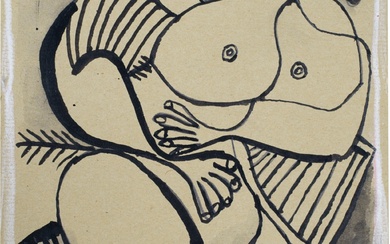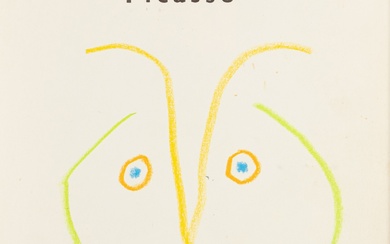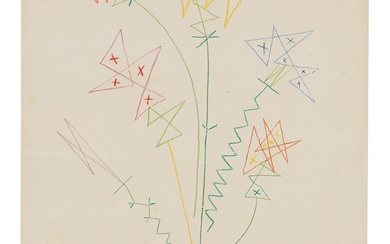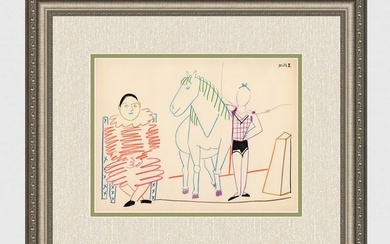Pablo Picasso, (Spanish, 1881-1973)
Femme nue à sa toilette
Femme nue à sa toilette
signed, dated and numbered '8.3.70.II Picasso' (upper left); inscribed and dated '8.3.70. Dimanche' (verso)
pencil on buff card
22.9 x 32.8cm (9 x 12 15/16in).
Executed on 8 March 1970
Provenance
Galerie Louise Leiris, Paris, no. 014301.
Galleria Schubert, Milan (acquired from the above circa 1970).
Marazzi Collection, Milan (acquired from the above circa 1985).
Galleria Schubert, Milan (acquired from the above circa 1988).
Private collection, Milan (acquired from the above circa 2000).
Exhibited
Paris, Galerie Louise Leiris, Dessins en noir et en couleurs, 15 December 1969 - 12 January 1971, no. 14.
Literature
C. Zervos, Pablo Picasso, Vol. 32, Oeuvres de 1970, Paris, 1977, no. 41 (illustrated pl. 24).
The Picasso Project (eds.), Picasso's Paintings, Watercolors, Drawings and Sculpture: The Final Years, 1970 - 1973, San Francisco, 2004, no. 70-041 (illustrated p. 19).
Drawn towards the end of Pablo Picasso's life, Femme nue à sa toilette shows a return to his early classical influences and expresses his abiding passion for life, art and desire itself: 'Picasso is eighty-nine in January of 1970, and he has sex on his mind' (The Picasso Project (eds.), Picasso's Paintings, Watercolors, Drawings and Sculpture: The Final Years, 1970 -1973, San Francisco, 2004, p. ix).
One of four sketches drawn on Sunday 8 March 1970, the present work comes from a period of great productivity, as Picasso created over 1,000 works between 1970 and 1973, with 194 drawings between 15 December 1969 and 12 January 1971 alone, leading to this finale being hailed 'a sumptuous beast' (P. Daix, Picasso, Life and Art, London, 1993, p. 363).
Many of the works from 1970 have an erotic theme, with female nudes shown making love, modelling in the artist's studio, being entertained by musicians and harlequins or as in the present work, bathing as the viewer looks on. Critics have linked both Picasso's depiction of the erotic and his frantic working pace with an attempt to defy old age. Despite having married his second wife Jacqueline Roque in 1961 and settling in the south of France, retirement was not on Picasso's mind: 'I have less and less time, and more and more to say' (P. Picasso quoted in B. Léal, C. Piot & M.-L. Bernadac, The Ultimate Picasso, New York, 2000, p. 464).
Images are increasingly repeated and reworked in these later years two further variations of the same nude, numbered I and III, were drawn on the same day as the present work and allow us to see how Picasso developed and pared down the composition. In the first sketch, Femme nue aux fleurs, the dynamic dramatically alters by having the nude look directly at the viewer. She holds a single flower stem in her hand and toys with her hair with the other, while opening her legs towards us. In Femme nue à sa toilette (III) we see the more innocent bather of the present work, washing herself oblivious to the voyeur, but gone are the flowers and extra accoutrements.
Speed was enabled by distilling images to their barest essence; Femme nue à sa toilette is created from sinuous lines with the sparsest of detail. A jumble of viewpoints allow the voyeuristic viewer to see the woman at her most voluptuous, as her plump arms, legs and rear are presented towards us. Picasso draws with deliberate confident lines, with no feathering or hesitation; the ends of her hair and even her toenails are captured in bold sweeps.
In its reduction of the nude to a few lines, the present work certainly references Picasso's long rivalry and friendship with Matisse, whom he first met in 1906. Picasso acknowledged his influence, stating that 'when Matisse died, he left his Odalisques to me as a legacy' (P. Picasso quoted in Exh. cat., Picasso, Artist of the Century, London, 1998, p. 108). A debt to Degas' bathers is also felt in the presentation of the woman at her toilette, seemingly oblivious to the onlooker's gaze, yet presented as an object of desire by an artist battling the effects of age on his body. Picasso explained in 1971 that 'desire remains. It's the same thing with making love. We don't do it anymore, but the desire for it is still with us' (P. Picasso quoted in Exh. cat., ibid. p. 53).
The female nude was a subject Picasso returned to and reworked throughout his life, dominating his engravings as well as drawings at this time. He had long admired the classical nudes of Ingres ('one must paint like Ingres [...] We must be like Ingres' (P. Picasso quoted in Exh. cat., Late Picasso, London, 1988, p. 36)) and paid homage to Le Bain turc in a series of engravings from 1968; the master's subject matter, and sensual and voyeuristic character perhaps lingers in the present work. Having previously broken down the female body into contorted facets, by 1970 Picasso sought to retain the figure's unity and a sense of overall harmony.
Drawn just three years before his death, Femme nue à sa toilette stands testament to Picasso's enduring skill as a draughtsman and illustrates the most timeless of subjects: 'Picasso was indeed the painter of women, ancient goddess, alma mater, man eater, swollen balloon, weeping woman, hysterical female, her body coiled like an egg or abandoned to sleep, a pile of exposed flesh, woman happily pissing, fertile mother, or courtesan. No painter has gone this far in unveiling the female universe' (B. Léal, C. Piot & M.-L. Bernadac, op. cit., p. 444).
View it on
Sale price
Time, Location
Auction House
Femme nue à sa toilette
Femme nue à sa toilette
signed, dated and numbered '8.3.70.II Picasso' (upper left); inscribed and dated '8.3.70. Dimanche' (verso)
pencil on buff card
22.9 x 32.8cm (9 x 12 15/16in).
Executed on 8 March 1970
Provenance
Galerie Louise Leiris, Paris, no. 014301.
Galleria Schubert, Milan (acquired from the above circa 1970).
Marazzi Collection, Milan (acquired from the above circa 1985).
Galleria Schubert, Milan (acquired from the above circa 1988).
Private collection, Milan (acquired from the above circa 2000).
Exhibited
Paris, Galerie Louise Leiris, Dessins en noir et en couleurs, 15 December 1969 - 12 January 1971, no. 14.
Literature
C. Zervos, Pablo Picasso, Vol. 32, Oeuvres de 1970, Paris, 1977, no. 41 (illustrated pl. 24).
The Picasso Project (eds.), Picasso's Paintings, Watercolors, Drawings and Sculpture: The Final Years, 1970 - 1973, San Francisco, 2004, no. 70-041 (illustrated p. 19).
Drawn towards the end of Pablo Picasso's life, Femme nue à sa toilette shows a return to his early classical influences and expresses his abiding passion for life, art and desire itself: 'Picasso is eighty-nine in January of 1970, and he has sex on his mind' (The Picasso Project (eds.), Picasso's Paintings, Watercolors, Drawings and Sculpture: The Final Years, 1970 -1973, San Francisco, 2004, p. ix).
One of four sketches drawn on Sunday 8 March 1970, the present work comes from a period of great productivity, as Picasso created over 1,000 works between 1970 and 1973, with 194 drawings between 15 December 1969 and 12 January 1971 alone, leading to this finale being hailed 'a sumptuous beast' (P. Daix, Picasso, Life and Art, London, 1993, p. 363).
Many of the works from 1970 have an erotic theme, with female nudes shown making love, modelling in the artist's studio, being entertained by musicians and harlequins or as in the present work, bathing as the viewer looks on. Critics have linked both Picasso's depiction of the erotic and his frantic working pace with an attempt to defy old age. Despite having married his second wife Jacqueline Roque in 1961 and settling in the south of France, retirement was not on Picasso's mind: 'I have less and less time, and more and more to say' (P. Picasso quoted in B. Léal, C. Piot & M.-L. Bernadac, The Ultimate Picasso, New York, 2000, p. 464).
Images are increasingly repeated and reworked in these later years two further variations of the same nude, numbered I and III, were drawn on the same day as the present work and allow us to see how Picasso developed and pared down the composition. In the first sketch, Femme nue aux fleurs, the dynamic dramatically alters by having the nude look directly at the viewer. She holds a single flower stem in her hand and toys with her hair with the other, while opening her legs towards us. In Femme nue à sa toilette (III) we see the more innocent bather of the present work, washing herself oblivious to the voyeur, but gone are the flowers and extra accoutrements.
Speed was enabled by distilling images to their barest essence; Femme nue à sa toilette is created from sinuous lines with the sparsest of detail. A jumble of viewpoints allow the voyeuristic viewer to see the woman at her most voluptuous, as her plump arms, legs and rear are presented towards us. Picasso draws with deliberate confident lines, with no feathering or hesitation; the ends of her hair and even her toenails are captured in bold sweeps.
In its reduction of the nude to a few lines, the present work certainly references Picasso's long rivalry and friendship with Matisse, whom he first met in 1906. Picasso acknowledged his influence, stating that 'when Matisse died, he left his Odalisques to me as a legacy' (P. Picasso quoted in Exh. cat., Picasso, Artist of the Century, London, 1998, p. 108). A debt to Degas' bathers is also felt in the presentation of the woman at her toilette, seemingly oblivious to the onlooker's gaze, yet presented as an object of desire by an artist battling the effects of age on his body. Picasso explained in 1971 that 'desire remains. It's the same thing with making love. We don't do it anymore, but the desire for it is still with us' (P. Picasso quoted in Exh. cat., ibid. p. 53).
The female nude was a subject Picasso returned to and reworked throughout his life, dominating his engravings as well as drawings at this time. He had long admired the classical nudes of Ingres ('one must paint like Ingres [...] We must be like Ingres' (P. Picasso quoted in Exh. cat., Late Picasso, London, 1988, p. 36)) and paid homage to Le Bain turc in a series of engravings from 1968; the master's subject matter, and sensual and voyeuristic character perhaps lingers in the present work. Having previously broken down the female body into contorted facets, by 1970 Picasso sought to retain the figure's unity and a sense of overall harmony.
Drawn just three years before his death, Femme nue à sa toilette stands testament to Picasso's enduring skill as a draughtsman and illustrates the most timeless of subjects: 'Picasso was indeed the painter of women, ancient goddess, alma mater, man eater, swollen balloon, weeping woman, hysterical female, her body coiled like an egg or abandoned to sleep, a pile of exposed flesh, woman happily pissing, fertile mother, or courtesan. No painter has gone this far in unveiling the female universe' (B. Léal, C. Piot & M.-L. Bernadac, op. cit., p. 444).







